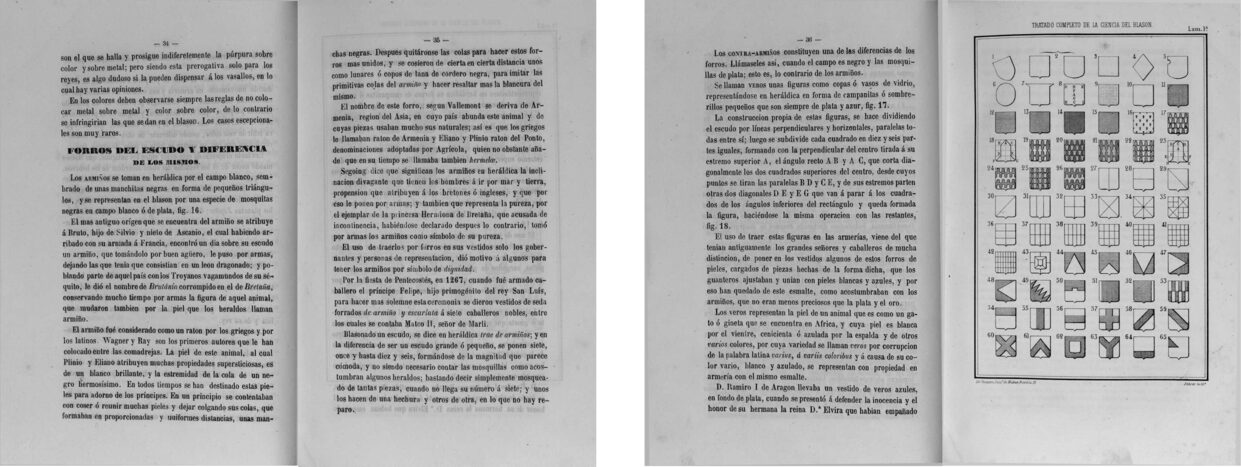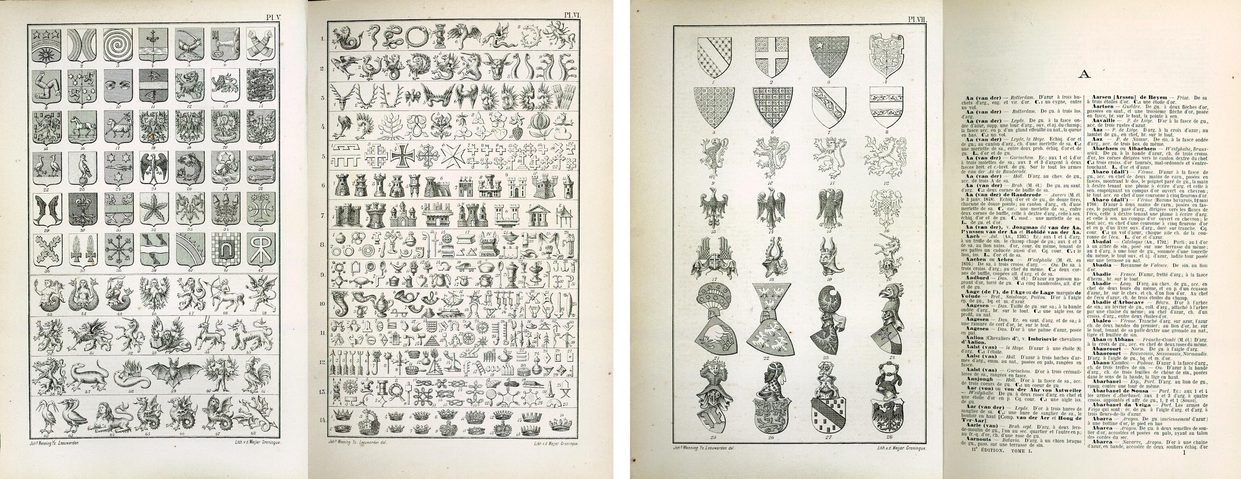Century XIX


![Ver [Bécquer, G. A.; 1862] en referencias bibliográficas. Libro abierto, hojas de plata, filo de oro, guardas de gules, tapas de sable.](../css/Libro.Bibliografia.png)
Bécquer, G. A.; 1862
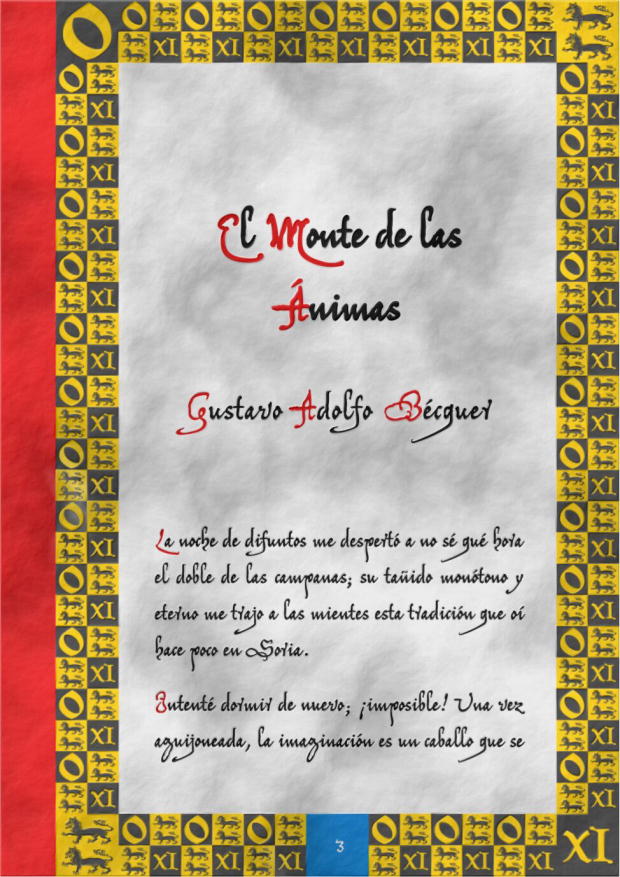
Gustavo Adolfo Bécquer (Gustavo Adolfo Domínguez Bastida), «The Mount of the Souls», published for the first time in the newspaper El Contemporáneo, along with 16 more legends, on November 7, 1862.
It was also edited a year after his death in his book titled «Rhymes and Legends», whose first edition of 1871 was prefaced by Rodríguez Correa and it was initially published in 2 volumes and later in 3 volumes.
The edition used in Blason.es is the one titled «Legends», edited by Ediciones aContracorriente, ISBN 978-84-939129-0-1, Madrid, 2011.
Bibliographical reference of century XIX.
The author is Bécquer, Gustavo Adolfo.
External link:


![Ver [Burke, B.; 1842] en referencias bibliográficas. Libro abierto, hojas de plata, filo de oro, guardas de gules, tapas de sable.](../css/Libro.Bibliografia.png)
Burke, B.; 1842
Sir Bernard Burke, C. B., LL. D., Ulster King of Arms, «The General Armory of England, Scotland, Ireland and Wales; Comprising a Registry of Armorial Bearings from the Earliest to the Present Time», Harrison, London, 1842.
Sir Bernard Burke, C. B., LL. D. (1814-1892), also cited as John Bernard Burke, was a British genealogist. He was son of the genealogist John Burke (1787–1848). In 1853, Sir Bernard Burke was appointed Ulster King of Arms.
I use to consult [Burke, B.; 1989] and [Burke, B.; 2009].
Bibliographical reference of century XIX.
Classification: In black and white and English language.
Author: Burke, Bernard.
Here are the articles quoting this reference:
External resource:


![Ver [Burke, J.; 1836] en referencias bibliográficas. Libro abierto, hojas de plata, filo de oro, guardas de gules, tapas de sable.](../css/Libro.Bibliografia.png)
Burke, J.; 1836
John Burke, «A Genealogical and Heraldic History of the Commoners of Great Britain and Ireland: Enjoying Territorial Possessions or High Official Rank; but Uninvested with Heritable Honours», 4 volumes, volume 1 with 726 printed pages, volume 2 with 740 printed pages, volume 3 with 738 printed pages, volume 4 with 805 printed pages, published for Henry Colburn by R. Bentley, Bell and Bradfute, in Edinburgh, and J. Gumming in Dublin, London, 1836.
Overview
This extensive work spans four volumes, 726 + 740 + 738 + 805 = 2309 pages, and provides a detailed account of the genealogy and heraldry of commoners in Great Britain and Ireland who held territorial possessions or high official ranks, yet were not vested with heritable honors.
Coats of arms and blazons
Each volume contains black and white illustrations of coats of arms, typically including the crest and wreath, with some also featuring supporters. The illustrations do not utilize hatching or tricking for tinctures, the tinctures must be seen in the text of the written blazons. For each lineage, the coat of arms is illustrated at the beginning, followed by a genealogical account, and the blazon is provided at the end. For example, for the Talbot lineage, in the volume 3, page 359-360, the blazon is written as follows: «Arms - Gu. a lion rampant, within a bordure engr. or. Crest - On a chapeau gu. turned up ermine, a lion statant or, the tail extended. Motto - Prest d'accomplir.» where «gu» is Gules and «or» is Or.
Bibliographical reference of century XIX.
Classification: Armorial roll, English language and In black and white.
The author is Burke, John.
Bibliographical reference mentioned in the following article:
External resources:
Internal resources: BurkeJ1836.Commoners.Volume.01.pdf 758 pages in PDF format, BurkeJ1836.Commoners.Volume.02.pdf 772 pages in PDF format, BurkeJ1836.Commoners.Volume.03.pdf 762 pages in PDF format and BurkeJ1836.Commoners.Volume.04.pdf 838 pages in PDF format.


![Ver [Costa y Turell, M.; 1858] en referencias bibliográficas. Libro abierto, hojas de plata, filo de oro, guardas de gules, tapas de sable.](../css/Libro.Bibliografia.png)
Costa y Turell, M.; 1858
Modesto Costa y Turell, «Tratado completo de la ciencia del blasón, o sea, Código heráldico-histórico; acompañado de una estensa noticia de todas las órdenes de caballería existentes y abolidas», Second edition corrected and augmented, 7 pages of prologue, 554 page, 26 pages with illustrations; size 25 centimeters, published by Libreria Española y Libreria de El Plus Ultra, Madrid, 1858.
Bibliographical reference of century XIX.
Classification: Castilian language and In black and white.
The author is Costa y Turell, Modesto.
Bibliographical reference mentioned in the following article:
External resources:
Internal resources: CostaTurellM1858.33.paginas.597.pdf in PDF format for Adobe Reader.


![Ver [Gourdon de Genouillac, H.; 1889] en referencias bibliográficas. Libro abierto, hojas de plata, filo de oro, guardas de gules, tapas de sable.](../css/Libro.Bibliografia.png)
Gourdon de Genouillac, H.; 1889
Henri Gourdon de Genouillac, «L'Art Héraldique», part of the series Bibliothèque de l'enseignement des Beaux-arts, published under the direction of M. Jules Comte, Maison Quantin, 290 pages, 21 centimeters, Paris, 1889.
With some black and white small illustrations, it covers the art of heraldry, its history, rules, and applications, and serves as a comprehensive guide for artists, historians, and those interested in the heraldic art.
Contents
- Chapter I. The blazon - Pieces and figures that compose coats of arms, page 11.
- Chapter II. Repertoire of attributes, page 98.
- Chapter III. External ornaments of the shield, their use, and their misuse, page 145.
- Chapter IV. Municipal arms, page 188.
- Chapter V. The blazon in the arts, page 200.
- Chapter VI. Blazoned garments, page 207.
- Chapter VII. Seals, tokens, méreaux of corporations, communities, page 214.
- Chapter VIII. The fleur-de-lis, the eagle, the lion, the leopard, various figures, page 222.
- Chapter IX. The blazon in England, Germany, and other nations, page 230.
- Chapter X. Explanatory glossary, page 252.
- Chapter XI. Heraldic bibliography, page 275.
Bibliographical reference of century XIX.
Classification: French language and In black and white.
The author is Gourdon de Genouillac, Henri.
The following article cites this bibliographic reference:
External resource:
Internal resources: GourdonDeGenouillacH1889.LArtHeraldique.pdf PDF version..


![Ver [Husenbeth, F. C.; 1882] en referencias bibliográficas. Libro abierto, hojas de plata, filo de oro, guardas de gules, tapas de sable.](../css/Libro.Bibliografia.png)
Husenbeth, F. C.; 1882
Frederick Charles Husenbeth, «Emblems of saints: by which they are distinguished in works of art», with 2 appendices «On the treatment of the Sibyls in art» by William Marsh and «On sacred heraldry» by Edward Lushington Blackburne, 3th edition edited by Augustus Jessopp, printed by A. H. Goose and Co. for the Norfolk and Norwich Archaeological Society, Norwich, 1882.
Bibliographical reference of century XIX.
Author: Husenbeth, Frederick Charles.
Bibliographical reference mentioned in the following article:
External resources:


![Ver [Lainé, P. L.; Lainé, J. J. L.; 1828] en referencias bibliográficas. Libro abierto, hojas de plata, filo de oro, guardas de gules, tapas de sable.](../css/Libro.Bibliografia.png)
Lainé, P. L.; Lainé, J. J. L.; 1828
P. Louis Lainé, J. J. L. Lainé, «Archives généalogiques et historiques de la noblesse de France, ou, Recueil de preuves, mémoires et notices généralogiques, servant à constater l'origine, la filiation, les alliances et lés illustrations religieuses, civiles et militaires de diverses maisons et familles nobles du royaume; Avec la collection des nobiliaires généraux des provinces de France», 11 volumes from 1828 to 1850, published by M. Lainé, printed by De Hauquelin et Dautriche, París, 1844.
Bibliographical reference of century XIX.
Classification: French language and In black and white.
Authors: Lainé, P. Louis and Lainé, J. J. L..
External resources:
- Google books, Volume I, 1828.
- Google books, Volume II, 1829.
- Google books, Volume III, 1830.
- Google books, Volume IV, 1834.
- Google books, Volume V, 1836.
- Google books, Volume VI, 1839.
- Google books, Volume VII, 1841.
- Google books, Volume VIII, 1843.
- Google books, Volume IX, 1844.
- Google books, Volume X, 1846.
- Google books, Volume XI, 1850.


![Ver [Langton, W.; 1876] en referencias bibliográficas. Libro abierto, hojas de plata, filo de oro, guardas de gules, tapas de sable.](../css/Libro.Bibliografia.png)
Langton, W.; 1876
William Langton, «The Visitation of Lancashire and a part of Cheshire, made in the twenty-fourth year of the reign of King Henry the Eighth, A.D. 1533, by special commission of Thomas Benolte (Benalt), Clarencieux», Chetham Society, Manchester, 1876.
In 1876 the first part of this book was published and in 1882 the second part. The cover of the book refers to «Thomas Benalt», but it might actually be «Thomas Benolte» or «Thomas Benolt»
Bibliographical reference of century XIX.
The author is Langton, William.
External resources:


![Ver [Lindsay, D.; 1822] en referencias bibliográficas. Libro abierto, hojas de plata, filo de oro, guardas de gules, tapas de sable.](../css/Libro.Bibliografia.png)
Lindsay, D.; 1822
Sir David Lindsay, «Facsimile of an Ancient Heraldic Manuscript Emblazoned by Sir David Lyndsay of the Mount, Lyon King of Arms, 1542», engraved by W. H. Lizars, published by W. & D. Laing, Edinburgh, 1822.
Bibliographical reference of century XIX.
Classification: English language and Black and white with color plates.
Author: Lindsay, David.
External link:
Internal resources: LindsayD1822.FacsimileHeraldicManuscript.pdf.


![Ver [Medél, R.; 1846] en referencias bibliográficas. Libro abierto, hojas de plata, filo de oro, guardas de gules, tapas de sable.](../css/Libro.Bibliografia.png)
Medél, R.; 1846
Ramon Medél, «The Spanish Blazon or Heraldic Science, Coats of Arms of the Different Kingdoms into which Spain has been divided, and of the Noble Families thereof», work adorned with 40 lithographed plates, printer J. Guerrero, Conde del Asalto Street 73, Barcelona, 1846.
The author's name «Ramon Medél» is written as the author himself writes it and not «Ramón Medel» as it is written in other bibliographies.
- The book first deals with the use of armories and the origin of the blazon, the shape of the coat of arms, the metals, colors, and linings, the partitions of the field and the honorable charges.
- Ramon Medél continues writing about the figures and other heraldic terms, organizing them as a dictionary almost until the end of the book, interspersing within this dictionary chapters dedicated to specific topics. For example, within the letter «C», he intersperses chapters on crowns, the crest, the mantling, the collars of orders, the «vanderas», the supporters and the supporters, the motto, the «pavilion», all the above including examples of specific blazons, the arms of Spain, covering all these topics within the letter «C» from page 84, after the term «cordado», to page 167, which begins with the term «corriendo», this makes it a bit difficult to use this book as a dictionary, unless the reader uses bookmarks. Likewise, within the letter «O», he includes a long chapter dedicated to the military orders and the crosses of distinction.
- After finishing the previous dictionary, in the final part of the book's text, he deals with the rules and the particular «exceptions» of blazon, the differences in armories, and the order in blazoning the coats of arms.
- From page 281, until the end of the book, it includes lithographs in both black and white and color, starting with a small royal coat of arms of Spain, ending with the coat of arms of Guillermo Ignacio Cifré de Colonia, and going through theoretical explanatory illustrations of partitions, charges, etc., civil coats of arms, family coats of arms, and even imaginary coats of arms such as the arms of El Cid Campeador or those of the Suevi kings.
Bibliographical reference of century XIX.
Author: Medél, Ramon.
Here are the articles quoting this reference:
- Castile and León, open royal crown
- Leonor Plantagenet and Alfonso VIII
- Leonor de Aquitania, escudo redondeado
- Our Lady of Mercy, Order of
- Province of Cáceres with Cross of Alcántara
Internal resources: MedelR1846.BlasonEspañolCienciaHeraldica.pdf.


![Ver [Nisbet, A.; 1816] en referencias bibliográficas. Libro abierto, hojas de plata, filo de oro, guardas de gules, tapas de sable.](../css/Libro.Bibliografia.png)
Nisbet, A.; 1816
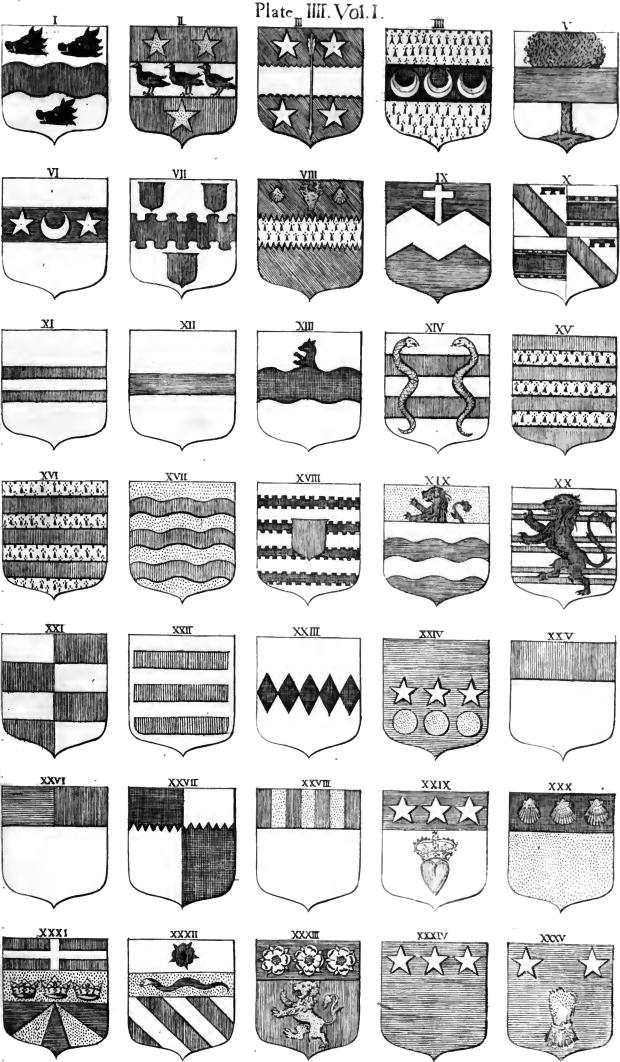
Alexander Nisbet, «System of Heraldry Speculative and Practical: With the True Art of Blazon», subtitle «according to the most approved heralds in Europe: illustrated with suitable examples of armoria figures, and achievements of the most considerable surnames and families in Scotland, together with historical and genealogical memorials relative thereto», printed by William Blackwood de Ediburgo and Rodwell and Martin of London, Edinburgh, 1816.
This is the edition I consult and the 1st edition of this book is [Nisbet, A.; 1722].
The illustration accompanying this bibliographic reference corresponds to page 43 of this edition of 1816.
Bibliographical reference of century XIX.
Author: Nisbet, Alexander.
Here are the articles quoting this reference:
External resources:
Internal resources: NisbetA1722.SystemHeraldry.pdf.


![Ver [Osmont, C.; 1858] en referencias bibliográficas. Libro abierto, hojas de plata, filo de oro, guardas de gules, tapas de sable.](../css/Libro.Bibliografia.png)
Osmont, C.; 1858
Charles Osmont, «L'Art Heraldique Contenant La Maniere d ' Apprendre Facillement Le Blason, Enrichy Des Figures Necessaires Pour L' Intelligence Des Termes», bound in leather, raised bands, title label, 8 preliminary leaves, 291 pages, and 35 plates, Paris, 1715.
Bibliographical reference of century XIX.
Classification: French language and In black and white.
Author: Osmont, Charles.
Internal resources: Physical book on paper.


![Ver [Parker, J. H.; 1847] en referencias bibliográficas. Libro abierto, hojas de plata, filo de oro, guardas de gules, tapas de sable.](../css/Libro.Bibliografia.png)
Parker, J. H.; 1847
John Henry Parker, «A Glossary of Terms Used in British heraldry, with a chronological table illustrative of its rise and progress», 360 pages with pictures, printed by J. Shrimpton, Oxford, 1847.
Author
John Henry Parker (1806-1884), the author of this book among others, was an English archaeologist, publisher, writer on architecture, member of The Most Honourable Order of the Bath (CB), and father of James Parker (1832 or 1833–1912), editor and author of [Parker, J.; 1894; A Glossary of Terms Used in Heraldry], a renewed edition of this book. Can be read about the relationship between these two books of father and son in [Stock, E.; 1895; The Antiquary, Volume XXXI].
In some places it is written that its author is Henry Gough, but I do not find within this book the author Henry Gough. The error is due to a later print of this book, see [Parker, J.; Gough, H.; 1966].
Parts of this book
- Preface, signed the 30th of November of 1846, pages I and II.
- Bibliography, with 21 bibliographic references in the page III, with 24 bibliographic references, including [Nisbet, A.; 1722] and 4 rolls of arms in the page IV, and with 4 bibliographic references in the page V.
- The page VI is empty.
- A chronological table illustrative of the rise and progress of armory, especially in England (see also shield, badge and crown) prom page VII to page XXIII.
- A list of all the abbats and priors of England who are known to have been mitred or to have sat in parliament subsequent to the beginning of the reign of Edward III, 2 pages XXIX and XXX,
- Glossary of terms used in british heraldry by alphabetical order, begining with «abased or abaissé» and ending with «zule», from page 1 to page 330.
- Addenda and corrigenda, from page 331 to 339.
- Alphabetical index, from page 341 to 360.
Bibliographical reference of century XIX.
Classification: Dictionary and English language.
Author: Parker, James Henry.
Here are the articles quoting this reference:
External links:
- Royal Collection Trust, RCIN 1052229, author John Henry Parker.
- John Henry Parker, archaeologist, writer and publisher.
- Archive.org (Henry Gough, erroneous co-author).
- Archive.org, document.
- Google books (Henry Gough, erroneous author).
Internal resources: ParkerJH1847.GlossaryTermsBritishHeraldry.pdf.


![Ver [Parker, J.; 1894] en referencias bibliográficas. Libro abierto, hojas de plata, filo de oro, guardas de gules, tapas de sable.](../css/Libro.Bibliografia.png)
Parker, J.; 1894
James Parker, «A Glossary of Terms Used in Heraldry, a New Edition with one Thousand Illustrations», XXVIII and 660 pages with pictures, edited by James Parker and Co., Oxford and London (at the 1st page), printed by James Parker and Co., Crown Yard (at page 660), Oxford, October of 1894.
Previous book and review
John Henry Parker, the father of James Parker, was also the editor and author of a previous book [Parker, J. H.; 1847; A Glossary of Terms Used in British heraldry]. James Parker, in the introduction of his book, writes about the innovations, updates and improvements he contemplates, which make it more a new book than a new edition of his father's.
A review and critics of this book can be readed in [Stock, E.; 1895; The Antiquary, Volume XXXI].
In some places it is written the name of Henry Gough as author of this book and, also, his father book, but I do not find within these books the author Henry Gough. The error is due to a later print of this book, see [Parker, J.; Gough, H.; 1966].
Bookplate and scanning process
The 6th of September of 2007, a copy of this book from the library of Harvard University was digitized by Google. This copy of the Harvard University has a bookplate with
- a first text «Harvard College Library»,
- the seal of Hardvard University with its coat of arms, and
- a second text «From the bequest of Mary Osgood of Medford, Massachusetts».
This scanning of Google has errors mainly in the very first 8 pages, and its images are not well viewed in all digital reproductors, but this scanning was used for some digital editors for make new digital versions of this book, for example, [Parker, J.; 2010].
The last scanned page contains the loan record of this library, with stamps from the year 1976 to 2000.
Frontispiece and Oxford arms
This book contains a frontispiece with the coat of arms of Richard Willoughby, Esq. (Esquire), son and heir, ob. s. p. (obiit sine prole, died without issue~offspring~children, at least, without legitimate ones) 1471. The explanation of the arms and quarters of Richard Willoughby are at the pages 396, 397, 398 and 399, under the term «marshalling» arms.
On the page next to the frontispiece, under the full title of this book, there is an oval version of the coat of arms of the University of Oxford from the Schools Tower erected A.D. 1619, its blazon is «Azure, an open Book Argent, leathered Sable and Gules, garnished Or, charged with the motto Dominus Illuminatio Mea; between three open crowns Or, two and one».
Bibliographical references and dates
- The father's book [Parker, J. H.; 1847].
- The son's book [Parker, J.; 1894].
- A review of the book [Stock, E.; 1895].
- A paper reprint [Parker, J.; Gough, H.; 1966].
- A paper reprint [Parker, J.; 1970].
- A paper reprint [Parker, J.; 1971].
- The Google scanning process, 2007.
- An example of a digital edition [Parker, J.; 2010].
Bibliographical reference of century XIX.
Classification: Dictionary and English language.
The author is Parker, James.
The following articles cite this bibliographic reference:
External resources:
- On-line version coded by Saitou.
- Archive.org (Henry Gough, erroneous co-author).
- Archive.org, document.
Internal resources: ParkerJ1894.GlossaryTermsHeraldry.pdf.


![Ver [Piferrer, F.; 1858] en referencias bibliográficas. Libro abierto, hojas de plata, filo de oro, guardas de gules, tapas de sable.](../css/Libro.Bibliografia.png)
Piferrer, F.; 1858
Francisco Piferrer, «Treatise on Heraldry and Blazonry», illustrated by José Asensio y Torres, 292 pages, revised, corrected, and expanded by the same author, printed by Antonio Espinosa, Madrid, 1858.
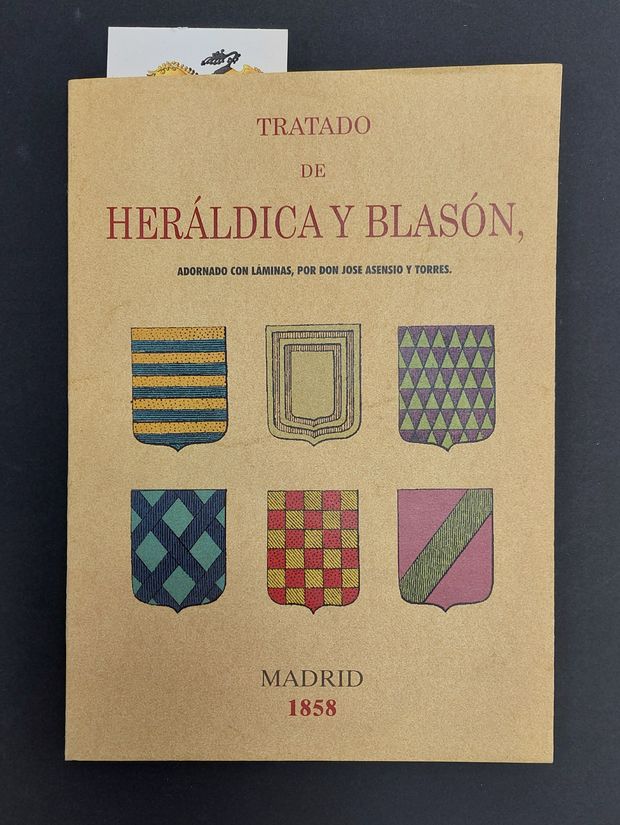
Francisco Piferrer was a 19th-century Spanish writer and historian, specialized in heraldry and genealogy. He was a prominent figure in the dissemination of nobiliary and heraldic history in Spain. Among his most notable works is this «Treatise on Heraldry and Blazon» published in 1858, a fundamental work that is still considered a reference in the field today. His work is valued for its meticulous documentation and for laying the foundations for other heraldic studies in Spain.
Bibliographical reference of century XIX.
Classification: De bibliotheca, Castilian language and In black and white.
Author: Piferrer, Francisco.
External links:
- University of Granada, book record.
- University of Granada, original scanned PDF, under a Creative Commons Attribution-NonCommercial-NoDerivs 3.0 License.
Internal resources: PiferrerF1858.22.TratadoHeraldicaBlason.UGr.B-014-074_2.pdf is the 1858 edition scanned into a digital PDF format by the University of Granada and A facsimile edition as a physical book on paper.


![Ver [Rietstap, J. B.; 1861] en referencias bibliográficas. Libro abierto, hojas de plata, filo de oro, guardas de gules, tapas de sable.](../css/Libro.Bibliografia.png)
Rietstap, J. B.; 1861
Johannes Baptista Rietstap, «Armorial général, précedé d'un Dictionnaire des termes du blason», edited by Gerrit Benjamin van Goor, 2 volumes, Volume I from A to K, 1149 páginas, Volume II from L to Z, 1316 páginas, Gouda, 1861.
Bibliographical reference of century XIX.
Classification: French language.
The author is Rietstap, Johannes Baptista.
Bibliographic reference mentioned in the following articles:
- Ackerson - Akers, lineage
- Amancier, lineage of Genevois
- Amitay Edward von Stiebel, collage
- Lineage Baldovino from Venecia, plain tincture
- Lineage Baldovino from Venecia, schema 2x2
- Malvin de Montazet, lineage of Languedoc
- Oschoven of the Rhin
- Talbot, lineage of England
- Urban V
External resources:
- Deuxième édition refondue et augmentée, 1884-1887, volume I, A-K.
- Deuxième édition refondue et augmentée, 1884-1887, volume II, L-Z.
- Gerrit Benjamin van Goor.
Internal resources: RietstapJB1861.10.ArmorialGeneral.A.Z.txt in ASCII format in French with 126,068 blazons, RietstapJB1861.10.ArmorialGeneral.A.Z.doc in Word format in French, RietstapJB1861.11.ArmorialGeneral.A.K.pdf in PDF format in French, RietstapJB1861.12.ArmorialGeneral.L.Z.pdf in PDF format in French and physical book on paper, 2 volumes.


![Ver [Rumor, S.; 1899] en referencias bibliográficas. Libro abierto, hojas de plata, filo de oro, guardas de gules, tapas de sable.](../css/Libro.Bibliografia.png)
Rumor, S.; 1899
Sebastiano Rumor, «Il Blasone Vicentino Descritto ed Illustrato», published by Venezia, A spese della Società, 310 pages of black and white text, 20 color plates, including: 1 plate at the beginning with 10 coats of arms, and 19 plates at the end, each containing 6 coats of arms, totaling 124 coats of arms, Venice, 1899.
Bibliographical reference of century XIX.
Classification: Italian language and Black and white with color plates.
Author: Rumor, Sebastiano.
External resource:
Internal resources: RumorS1899.IlBlasoneVicentino.pdf PDF format.


![Ver [Rylands, J. P.; 1882] en referencias bibliográficas. Libro abierto, hojas de plata, filo de oro, guardas de gules, tapas de sable.](../css/Libro.Bibliografia.png)
Rylands, J. P.; 1882
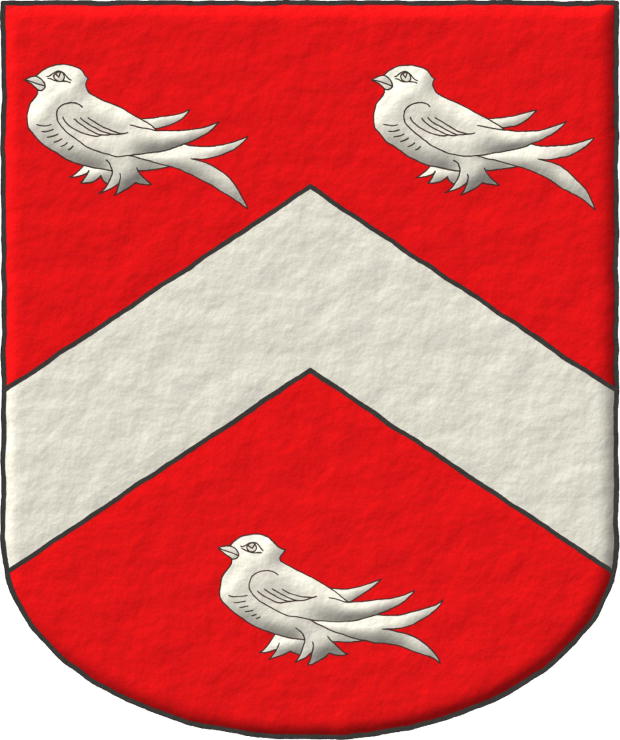
John Paul Rylands, «The Visitation of Cheshire in the Year 1580, Made by Robert Glover, Somerset Herald, for William Flower, Norroy King of Arms, with Numerous Additions and Continuations, Including those from The Visitation of Cheshire in the Year 1566, by the same Herald, with an Appendix Containing The Visitation of a Part of Cheshire in the Year 1533, William Fellows, Lancaster Herald, for Thomas Benolte, Clarenceux King Of Arms, And a Fragment of The Visitation of the City of Chester in the Year 1591, Made by Thomas Chaloner, Deputy to the Office Of Arms», edited by John Paul Rylands, F. S. A., published by The Harleian Society, London, 1882.
[Goldstraw, M. S. J.; 2013a] es una recreación a color de los escudos registrados en este libro.
El escudo que ilustra esta referencia bibliográfica es uno de los que se registran en este libro y corresponde al escudo de Tatton de Wythenshawe, con la diferencia que aquí no se ha incluido su timbre.
Bibliographical reference of century XIX.
The author is Rylands, John Paul.
Bibliographical reference mentioned in the following article:


![Ver [Stock, E.; 1895] en referencias bibliográficas. Libro abierto, hojas de plata, filo de oro, guardas de gules, tapas de sable.](../css/Libro.Bibliografia.png)
Stock, E.; 1895
Elliot Stock, «The Antiquary, A Magazine Devoted to the Study of the Past», Volume XXXI, Published by Elliot Stock, London, 1895.
Glossary of Terms used in British Heraldry
«The late Mr. John Henry Parker's name is so closely associated with quite a small library of admirable manuals on architecture, and with a number of other works on archaeology, all of which are well known, that it will be something of a surprise to many persons to learn that about fifty years ago», 1895 - 1847 = 48 years, «he published» [Parker, J. H.; 1847; Glossary of Terms used in British Heraldry].
«The book, too, has been out of print so long that it has become almost forgotten».
Glossary of Terms used in Heraldry, a new book
«The new edition now published by his son, Mr. James Parker», [Parker, J.; 1894; Glossary of Terms used in Heraldry], «is practically, as he himself tells us, a new book, and the elaboration and care which have been bestowed upon it are as characteristic of this as they are of the other archaeological works, for which both father and son have been so honourably distinguished for more than half a century».
Illustrations
«Another well-known characteristic of the Messrs. Parker's books is the copious manner in which they are illustrated».
«The present volume fully maintains that reputation, and the neat little woodcuts, which occur in great profusion on nearly every other page, are often a great help in explaining in a practical manner the significance of a heraldic term».
«To anyone who is beginning the study of heraldry this will render the book of great value and usefulness; while others who know more or less of the science will not be disposed to regret the lavish manner in which explanatory illustrations are provided».
Critic, Chichester and Prester John
«So far as it is possible to judge there are very few, if any, inaccuracies in the book, although we are bound to express surprise in finding in such a work as this, the old fiction repeated, that the figure of our Saviour, in relation to the dedication of the cathedral to the Holy Trinity, on the arms of the See of Chichester is that of the mysterious being known as Prester John».
«We thought this absurd theory had been fully exploded long ago, and to find it perpetuated in a work like this is a little startling, to say the least».
The 3 main references in James Parker's book to Prester John the See of Chichester are the following:
- About the Presbyter John, usually called Prester John: «this singular figure is represented as seated on a stone (described as a tombstone), and forms the insignia of the See of Chichester, the only instance in which the bearing occurs», [Parker, J.; 1894; page 476]. «The origin of the figure is obscure». «In 1180 the seal represented the Figure of Christ seated on a Tomb, with perhaps a symbolical reference to» the Book of Revelation i. 16, and v. 1, also called the Apocalypse of John the Apostle. «Early in the next century the mythical story of Prester John, a supposed King of central Asia, was current, a certain Franciscan monk, by name Carpini, who went out as a Missionary in 1206, having brought home or invented the story, and this being very popular was afterwards, perhaps, applied to the device».
- About the blazon of the Bishopric of Chichester, he writes «Bishoprick»: «Azure, a Presbyter John hooded sitting on a tombstone, in his sinister hand a book open, his dexter hand extended with the two forefingers erect, all or; in his mouth a sword fessways gules, hilt and pommel or, the point to the sinister», [Parker, J.; 1894; at the end of the page 476].
- About «tombstone» as an heraldic term, [Parker, J.; 1894; page 576] writes: «the seat of Prester John (q.v.)» ~ quod vide ~ which see «in the insignia of the See of Chichester, and of Saint Mary in those of the See of Lincoln», see also the term nimbus or «Cicle of Glory» at [Parker, J.; 1894; page 424], «is so called, though in neither case is it at all probable that the bearing is intended for such».
«It would be an interesting fact to ascertain exactly when and by whom», Elliot Stock asks himself, «the very wild idea of Prester John on the Chichester shield was first started».
Nowadays, the Diocese of Chichester, in its on-line explanation about its coat of arms, writes «The most common misconception, which was still being repeated in 1894», the Diocese does not cite directly James Parker's book, but cites its publishing year 1894, «was that the arms show Presbyter John sitting on a tombstone». «A letter circulated in Europe in about 1165 referred to the annual visit of Prester John and his army, complete with chariots and elephants, to the tomb of the prophet Daniel in Babylonia Deserta». «It was the imagery of this letter», about the Prester John and the tomb, «that seems to have become attached to» the coat of arms of the Diocese of Chichester with its human figure, nimbed, sitting in a tomb or an altar.
Conclusions
«As showing the thoroughness with which Mr. James Parker has done his work, we may mention that»:
- «no less than 32 pages are taken up in describing the different heraldic forms and uses of the cross», [Parker, J.; 1894; from the page 149 to the beginning of the page 179] and with an internal index, dedicated exclusively to the cross, on [Parker, J.; 1894; pages 179 and 180].
- «and 8 with the various forms of the crown», [Parker, J.; 1894; from the page 181 to the page 188].
«In every instance the subject dealt with is thoroughly worked out».
«Indeed, thoroughness may be said to be one of the special characteristics of this useful and welcome volume».
Elliot Stock, the reviewer
He was an English publisher and bibliophile, he born in 1838 and died in 1911. The publishing company that bore his name was in business from 1859 to 1939. The Antiquary magazine was published by his publishing company from December 1879 to 1915.
Bibliographical reference of century XIX.
Classification: Magazine and English language.
Author: Stock, Elliot.
Here are the articles quoting this reference:
External links:
- The Antiquary, Volume XXXI, datails.
- The Antiquary, Volume XXXI, contents.
- Elliot Stock, publisher of the The Antiquary.
- Chichester, Coat of arms of the Diocese.


![Ver [Stodart, R. R.; 1881] en referencias bibliográficas. Libro abierto, hojas de plata, filo de oro, guardas de gules, tapas de sable.](../css/Libro.Bibliografia.png)
Stodart, R. R.; 1881
Robert Riddle Stodart, «Scottish Arms: Being a Collection of Armorial Bearings, A.D. 1370-1678», Reproduced in facsimile from contemporary manuscripts with heraldic and genealogical notes, edited by William Paterson, Edinburgh, 1881.
This work is a comprehensive two-volume set that reproduces armorial bearings from various manuscripts dating from 1370 to 1678. The collection includes detailed heraldic and genealogical notes that accompany the facsimiles. It is an essential reference for anyone studying Scottish heraldry and genealogy.
Volume 1
Volume 1 contains an introduction, an alphabetical index of coats of arms, and 125 color plates, each displaying between 1 and 9 coats of arms per plate. This volume 1 is dedicated to the color illustrations of the coats of arms, while volume 2 consists entirely of text without illustrations. In volume 1, the Plates section with color illustrations of coats of arms follows the same structure as volume 2, as will be seen in the section dedicated to volume 2. The contents of volume 1 are as follows.
- Introduction.
- Index to the plates.
- List of names in the order in which they occur on the plates.
-
Plates:
- Armorial de Gelre, pages A to E.
- Armorial de Berry, pages I to II.
- Forman's Roll, pages 12 to 21.
- Sunderland Hall Ms., pages 22 to 24.
- Additions to Sir David Lindsay's Ms., pages 24^ to 34.
- Workman's Ms, pages 35 to 84.
- Kings' and Nobility's arms, pages 85 and 86.
- Sir David Lindsay the Youngers Ms, pages 87 to 94.
- Sir James Balfour's Ms, pages 95 and 96.
- Lyon register, pages 97 and 98.
- Earl of Crawford's Ms., pages 99 and 100.
- Gentlemen's arms, pages 101 to 106.
- Funeral escutcheons, pages 106 to 110.
- Sundries, pages 111 to 118.
- Heraldic and genealogical notes.
- Index to the notes.
- Additions and corrections.
Volume 2
Volume 2 continues the collection and includes further armorial bearings and notes and also references several historical armorials, with the following contents:
- I. The armorial de Gelre, circa 1369.
- II. The armorial de Gilles le Bouvier, Berry Roi d'Armes, circa 1450-55.
- III. Roll of arms, by sir Robert Forman, Lyon King of Arms, circa 1562.
- IV. Sunderland Hall manuscript.
- V. Additions to the booke and register of armes, compiled by sir David Lindsay, Lyon King of Arms.
- VI. Illuminated heraldic manuscript, called "Workman's," circa 1565-6.
- VII. Kings' and nobility's arms, circa 1566.
- VIII. Illuminated manuscript, circa 1603-5, ascribed to sir David Lindsay, Lyon King of Arms.
- IX. Armorial manuscripts by sir James Balfour, Baronet, Lyon King at Arms 1630-54, and another herald.
- X. The public register of all arms and bearings in Scotland, A.D. 1672-78.
- XI. Heraldic manuscript compiled during the reign of James VI, the property of the Earl of Crawford and Balcarres.
- XII. Gentlemen's arms collected during the reign of Charles I.
- XIII. Funeral escutcheons.
- XIV. Sundries.
Bibliographical reference of century XIX.
Classification: Armorial roll, English language and Black and white with color plates.
Author: Stodart, Robert Riddle.
External resources:
Internal resources: StodartR1881.ScottishArms.Heavy.Volume.01.pdf Heavy PDF, StodartR1881.ScottishArms.Heavy.Volume.02.pdf Heavy PDF, StodartR1881.ScottishArms.Light.Volume.01.pdf Light PDF and StodartR1881.ScottishArms.Light.Volume.02.pdf Light PDF.


![Ver [Ströhl, H. G.; 1891] en referencias bibliográficas. Libro abierto, hojas de plata, filo de oro, guardas de gules, tapas de sable.](../css/Libro.Bibliografia.png)
Ströhl, H. G.; 1891
Hugo Gerard Ströhl, «Die Wappen der Buchgewerbe», published by Anton Schroll & Co., 36 pages with black and white illustrations, plus 1 title page, 9 color plates, and 1 additional color plate, Vienna, 1891.
This book is a notable work in the field of heraldry, specifically focusing on the coats of arms related to the book trade industries. Ströhl, a renowned heraldic artist, created detailed illustrations that highlight the symbolism and artistic elements of these armorial bearings. The publication includes a combination of black and white illustrations alongside vivid color plates that showcase the vibrancy of heraldic art in the late 19th century.
Hugo Gerard Ströhl was born on September 24, 1851, in Wels, Austria, and passed away on December 7, 1919, in Mödling, Austria. His works remain influential in the study and appreciation of heraldic art.
Bibliographical reference of century XIX.
Classification: Armorial roll, German language and Black and white with color plates.
The author is Ströhl, Hugo Gerard.
External links:
- Heraldry of the World, Biography of Hugo Gerard Ströhl.
- Payhip download of the book.
- Information about the book at Rice University Library.
Internal resources: Strohl1891.DieWappenDerBuchgewerbe.pdf in PDF format.


![Ver [Wade, W. C.; 1898] en referencias bibliográficas. Libro abierto, hojas de plata, filo de oro, guardas de gules, tapas de sable.](../css/Libro.Bibliografia.png)
Wade, W. C.; 1898
William Cecil Wade, «The symbolisms of heraldry or A treatise on the meanings and derivations of armorial bearings», 186 pages, 95 black and white pictures, Robert Holmes Collection, published by George Redway, London, 1898.
Although Romanticism sought the symbolism of the heraldic elements, I believe that the meaning of the elements of the coat of arms, if they have it, is provided by its creator or first bearer. In any case, the content of this symbolic book is the following:
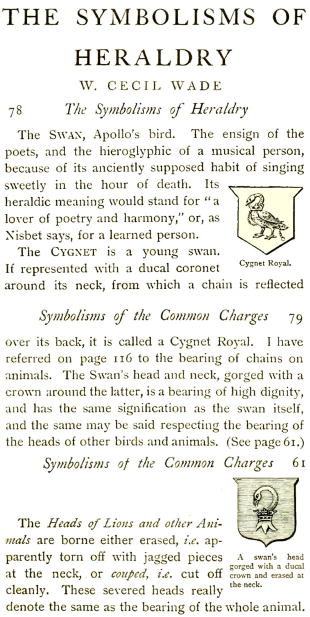
- The origin of armorial bearings; page 11.
- The symbolic side of heraldry; page 13.
- Heraldic colors and metals; page 35.
- The furs of heraldry; page 38.
- The meaning of heraldic lines; page 40.
- The symbolisms of the ordinaries; page 43.
- The division lines of the shield; page 55.
- The colors of the common charges not symbolical, chapter with 2 paragraphs only; page 57.
- Symbolisms of the common charges; page 59.
- Crowns, mitres, episcopal hats, etc.; page 138.
- Examples of symbolisms of colors and armorial bearings; page 149.
- Cadency and differencing; page 154.
- Alphabetic index; page 162.
Bibliographical reference of century XIX.
Classification: Symbolism, In black and white and English language.
Author: Wade, William Cecil.
The following article cites this bibliographic reference:
External resource:
Internal resources: WadeWC1898.SymbolismsHeraldry.pdf.


![Ver [Winkler, P. P. von; 1892] en referencias bibliográficas. Libro abierto, hojas de plata, filo de oro, guardas de gules, tapas de sable.](../css/Libro.Bibliografia.png)
Winkler, P. P. von; 1892
Pavel Pavlovich von Winkler, «Russian Heraldry: History and Description of Russian Coats of Arms with Illustrations of All the Coats of Arms of the Nobility, included in the General Armorial of the Russian Empire», printed by Typography and Lithography of I. A. Efron, Prachechny Passage, Building 6, 3 volumes, Volume 1, year 1892, 59 pages, 275 illustrations, includes a preface to the first volume, an index, basics of heraldry, and an armorial, Volume 2, year 1894, 71 pages, 302 illustrations, includes a preface to the second volume, an index, and an armorial, Volume 3, year 1894, 71 pages, 326 illustrations, includes a preface to the third volume, an index, and an armorial, St. Petersburg, 1892, 1894.
Description
This work by Pavel Pavlovich von Winkler is a comprehensive three-volume series on Russian heraldry, exploring the history and detailed descriptions of Russian coats of arms.
The first volume includes an introduction to heraldry, making it accessible to readers new to the subject. Each volume expands on specific aspects of Russian heraldry, providing an analysis and cataloging of various coats of arms throughout Russia's history.
Bibliographical reference of century XIX.
Classification: Armorial roll, Russian language and In black and white.
The author is Winkler, Pavel Pavlovich von.
Internal resources: WinklerPvon1892.Tomo.01 Pdf format, WinklerPvon1894.Tomo.02 Pdf format and WinklerPvon1894.Tomo.03 Pdf format.
-
Language
-
Categories of heraldry
-
Divisions of the field
- Without divisions
- Party per pale
- Party per fess
- Party per bend
- Party per bend sinister
- Tierce
- Tierce sinister
- Tierced per pale
- Tierced per fess
- Tierced per bend
- Tierced pallwise inverted
- Quarterly
- Quarterly per saltire
- Gyronny
- Party per fess, the chief per pale
- Party per pale, the sinister per fess
- Party per fess, the base per pale
- Party per pale, the dexter per fess
- Chapé
- Chaussé
- Embrassé
- Contre-embrassé
- Party per chevron
- Enté
- Enté en point
- Flanched
-
Metals
-
Colours
-
Furs
-
Other tinctures
-
Ordinaries and sub-ordinaries
-
Diminutives of the ordinaries
-
Geometric charges
-
Composite ordinaries
-
Inanimate charges from Nature
Atom, Crescent, Diamond, Emerald, Estoile, Increscent, Lightning flash, Moon, Mount, Mullet, Mullet of four points, Orbital, Plough of Ursa Major, Rainbow, Ray of the sun, River, Sea, Snowflake, Sun, Sun in splendour, Sun of May, Trimount, Water and Wave.
-
Vegetal charges from Nature
Acorn, Apple, Apple tree, Ash, Bluebonnet, Camellia, Chrysanthemum, Cinquefoil, Cornflower, Dogwood flower, Double rose, Elm, Fleur de lis, Flower, Gourd, Holm oak, Hop cone, Kapok tree, Laurel, Lily, Linden, Lotus flower, Madonna lily, Mexican cedar tree, Oak, Olive tree, Palm tree, Plantain plant, Pomegranate, Poplar leaf, Rose, Shamrock, Sunflower, Thistle, Tree, Tulip, Vine and Wheat.
-
Animal charges from Nature
Badger, Bald eagle, Barbel, Barn owl, Bear, Beaver, Beetle, Bighorn sheep, Blackbird, Boar, Brach hound, Bull, Doe, Dog, Dolphin, Dove, Eagle, Elephant, Falcon, Female figure, Fish, Flame, Fly, Fox, Frog, Goat, Goldfinch, Goose, Heron, Horse, Hummingbird, Jaguar, Lark, Leopard, Lion, Lion passant, Lion rampant guardant, Lioness, Lynx, Male figure, Martlet, Merino ram, Owl, Panther, Parrot, Peacock, Pelican, Pelican in her piety, Puffin, Quetzal, Raven, Roe deer, Rooster, Savage, Seagull, Serpent, She-wolf, Stag, Starling, Talbot, Tyger, Vulture, Warren hound and Wolf.
-
Parts of natural charges
Arm, Beak, Branch, Caboshed, Chest, Claw, Covert, Dorsal fin, Eagle claw, Ermine spot, Escallop, Feather, Foot (palmiped), Foreleg, Forepaw, Hand, Head, Heart, Hoof, Leaf, Neck, Ostrich feather, Palm frond, Paw, Roe deers' attires, Shoulder, Sprig, Stags' attires, Stem, Swallow-tail, Tail, Tail addorsed, Tail fin, Talon, Tooth, Trunk, Trunk (elephant), Two hands clasped, Two wings in vol, Udder, Wheat spike, Wing and Wrist.
-
Artificial charges
Ace of spades, Anchor, Anvil, Arch, Arm vambraced, Armillary sphere, Arrow, Axe, Bell, Bell tower, Beret, Bonfire, Book, Bookmark, Bow, Branding iron, Bridge, Broken, Buckle, Cannon, Cannon dismounted, Cannon port, Canopy roof, Carbuncle, Castle, Celtic Trinity knot, Chain, Chess rooks, Church, Clarion, Clay pot, Closed book, Club, Column, Comb, Compass rose, Conductor's baton, Cord, Covered cup, Crozier, Crucible, Cuffed, Cup, Cyclamor, Dagger, Double vajra, Drum, Ecclesiastical cap, Fanon, Federschwert, Fleam, Four crescents joined millsailwise, Galician granary, Garb, Gauntlet, Geometric solid, Grenade, Halberd, Hammer, Harp, Host, Hourglass, Key, Key ward, Knight, Knot, Lantern, Letter, Line, Loincloth, Menorah, Millrind, Millstone, Millwheel, Monstrance, Mortar, Mullet of six points pierced, Nail, Non-classic artifact, Norman ship, Number, Oar, Oil lamp, Open book, Page, Pair of scales, Parchment, Pestle, Piano, Pilgrim's staff, Plough share, Polish winged hussar, Port, Portcullis, Potent, Quill, Ribbon, Rosette of acanthus leaves, Sabre, Sackbut, Sail, Scroll, Scythe, Sheaf of tobacco, Ship, Skirt, Spear, Spear's head, Stairway, Star of David, Step, Sword, Symbol, Tetrahedron, Torch, Tower, Trident, Trumpet, Turret, Two-handed sword, Wagon-wheel, Water-bouget, Wheel, Winnowing fan and With a turret.
-
Immaterial charges
Angel, Archangel, Basilisk, Dragon, Dragon's head, Garuda, Golden fleece, Griffin, Heart enflamed, Justice, Mermaid, Our Lady of Mercy, Ouroboros, Paschal lamb, Pegasus, Phoenix, Sacred Heart of Jesus, Saint George, Sea-griffin, Trinity, Triton, Unicorn, Winged hand and Wyvern.
-
External elements
-
Heraldic creations
-
References
-
Formats
-
Keywords on this page
Between, Armorial roll, Bibliography, Chevron, Cheshire County, Quarterly, De bibliotheca, Dictionary, In black and white, Black and white with color plates, Genealogy, Gules, German language, Castilian language, French language, English language, Italian language, Russian language, Lineage, Martlet, Ordered, Argent, Without divisions, Kingdom of France, Religious, Magazine, Century XIX and Symbolism.

